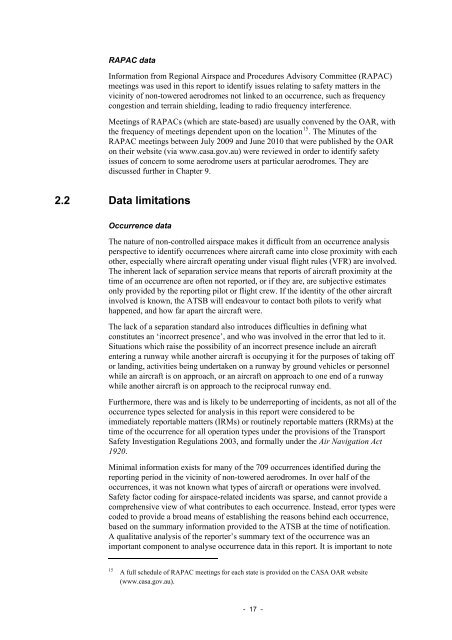Safety in the vicinity of non-towered aerodromes - Australian ...
Safety in the vicinity of non-towered aerodromes - Australian ...
Safety in the vicinity of non-towered aerodromes - Australian ...
You also want an ePaper? Increase the reach of your titles
YUMPU automatically turns print PDFs into web optimized ePapers that Google loves.
RAPAC data<br />
Information from Regional Airspace and Procedures Advisory Committee (RAPAC)<br />
meet<strong>in</strong>gs was used <strong>in</strong> this report to identify issues relat<strong>in</strong>g to safety matters <strong>in</strong> <strong>the</strong><br />
vic<strong>in</strong>ity <strong>of</strong> <strong>non</strong>-<strong>towered</strong> <strong>aerodromes</strong> not l<strong>in</strong>ked to an occurrence, such as frequency<br />
congestion and terra<strong>in</strong> shield<strong>in</strong>g, lead<strong>in</strong>g to radio frequency <strong>in</strong>terference.<br />
Meet<strong>in</strong>gs <strong>of</strong> RAPACs (which are state-based) are usually convened by <strong>the</strong> OAR, with<br />
<strong>the</strong> frequency <strong>of</strong> meet<strong>in</strong>gs dependent upon on <strong>the</strong> location 15 . The M<strong>in</strong>utes <strong>of</strong> <strong>the</strong><br />
RAPAC meet<strong>in</strong>gs between July 2009 and June 2010 that were published by <strong>the</strong> OAR<br />
on <strong>the</strong>ir website (via www.casa.gov.au) were reviewed <strong>in</strong> order to identify safety<br />
issues <strong>of</strong> concern to some aerodrome users at particular <strong>aerodromes</strong>. They are<br />
discussed fur<strong>the</strong>r <strong>in</strong> Chapter 9.<br />
2.2 Data limitations<br />
Occurrence data<br />
The nature <strong>of</strong> <strong>non</strong>-controlled airspace makes it difficult from an occurrence analysis<br />
perspective to identify occurrences where aircraft came <strong>in</strong>to close proximity with each<br />
o<strong>the</strong>r, especially where aircraft operat<strong>in</strong>g under visual flight rules (VFR) are <strong>in</strong>volved.<br />
The <strong>in</strong>herent lack <strong>of</strong> separation service means that reports <strong>of</strong> aircraft proximity at <strong>the</strong><br />
time <strong>of</strong> an occurrence are <strong>of</strong>ten not reported, or if <strong>the</strong>y are, are subjective estimates<br />
only provided by <strong>the</strong> report<strong>in</strong>g pilot or flight crew. If <strong>the</strong> identity <strong>of</strong> <strong>the</strong> o<strong>the</strong>r aircraft<br />
<strong>in</strong>volved is known, <strong>the</strong> ATSB will endeavour to contact both pilots to verify what<br />
happened, and how far apart <strong>the</strong> aircraft were.<br />
The lack <strong>of</strong> a separation standard also <strong>in</strong>troduces difficulties <strong>in</strong> def<strong>in</strong><strong>in</strong>g what<br />
constitutes an ‘<strong>in</strong>correct presence’, and who was <strong>in</strong>volved <strong>in</strong> <strong>the</strong> error that led to it.<br />
Situations which raise <strong>the</strong> possibility <strong>of</strong> an <strong>in</strong>correct presence <strong>in</strong>clude an aircraft<br />
enter<strong>in</strong>g a runway while ano<strong>the</strong>r aircraft is occupy<strong>in</strong>g it for <strong>the</strong> purposes <strong>of</strong> tak<strong>in</strong>g <strong>of</strong>f<br />
or land<strong>in</strong>g, activities be<strong>in</strong>g undertaken on a runway by ground vehicles or personnel<br />
while an aircraft is on approach, or an aircraft on approach to one end <strong>of</strong> a runway<br />
while ano<strong>the</strong>r aircraft is on approach to <strong>the</strong> reciprocal runway end.<br />
Fur<strong>the</strong>rmore, <strong>the</strong>re was and is likely to be underreport<strong>in</strong>g <strong>of</strong> <strong>in</strong>cidents, as not all <strong>of</strong> <strong>the</strong><br />
occurrence types selected for analysis <strong>in</strong> this report were considered to be<br />
immediately reportable matters (IRMs) or rout<strong>in</strong>ely reportable matters (RRMs) at <strong>the</strong><br />
time <strong>of</strong> <strong>the</strong> occurrence for all operation types under <strong>the</strong> provisions <strong>of</strong> <strong>the</strong> Transport<br />
<strong>Safety</strong> Investigation Regulations 2003, and formally under <strong>the</strong> Air Navigation Act<br />
1920.<br />
M<strong>in</strong>imal <strong>in</strong>formation exists for many <strong>of</strong> <strong>the</strong> 709 occurrences identified dur<strong>in</strong>g <strong>the</strong><br />
report<strong>in</strong>g period <strong>in</strong> <strong>the</strong> vic<strong>in</strong>ity <strong>of</strong> <strong>non</strong>-<strong>towered</strong> <strong>aerodromes</strong>. In over half <strong>of</strong> <strong>the</strong><br />
occurrences, it was not known what types <strong>of</strong> aircraft or operations were <strong>in</strong>volved.<br />
<strong>Safety</strong> factor cod<strong>in</strong>g for airspace-related <strong>in</strong>cidents was sparse, and cannot provide a<br />
comprehensive view <strong>of</strong> what contributes to each occurrence. Instead, error types were<br />
coded to provide a broad means <strong>of</strong> establish<strong>in</strong>g <strong>the</strong> reasons beh<strong>in</strong>d each occurrence,<br />
based on <strong>the</strong> summary <strong>in</strong>formation provided to <strong>the</strong> ATSB at <strong>the</strong> time <strong>of</strong> notification.<br />
A qualitative analysis <strong>of</strong> <strong>the</strong> reporter’s summary text <strong>of</strong> <strong>the</strong> occurrence was an<br />
important component to analyse occurrence data <strong>in</strong> this report. It is important to note<br />
15<br />
A full schedule <strong>of</strong> RAPAC meet<strong>in</strong>gs for each state is provided on <strong>the</strong> CASA OAR website<br />
(www.casa.gov.au).<br />
- 17 -
















